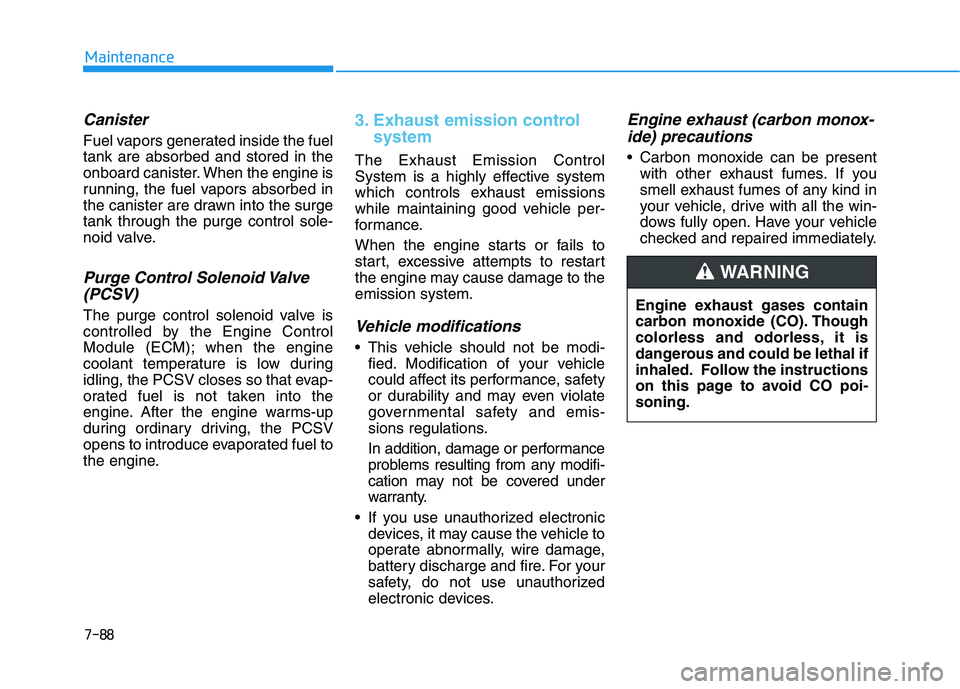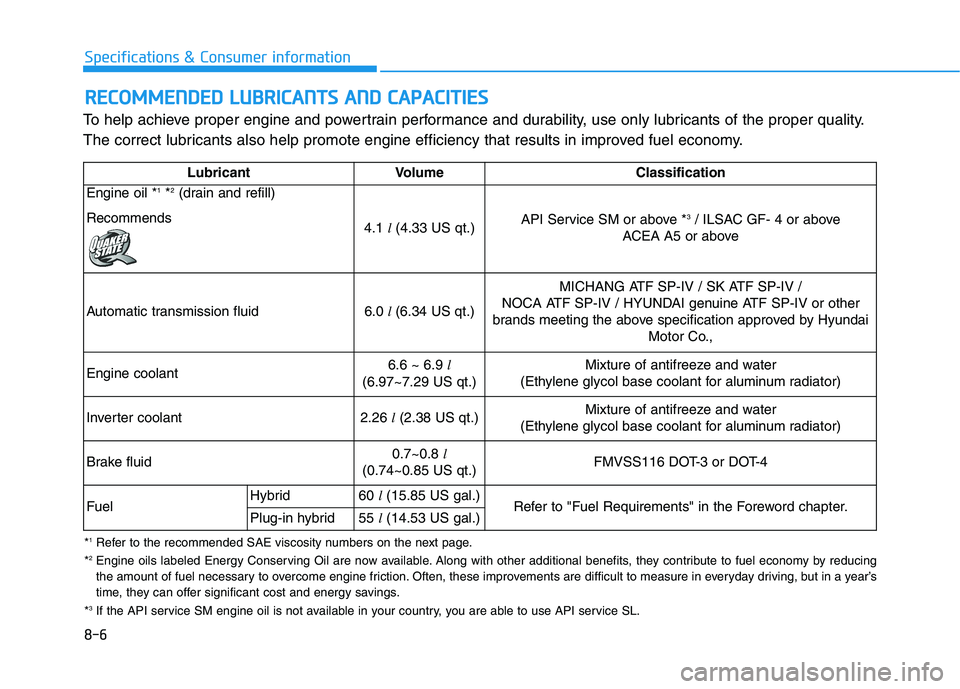Page 526 of 546

7-88
Maintenance
Canister
Fuel vapors generated inside the fuel tank are absorbed and stored in the
onboard canister. When the engine is
running, the fuel vapors absorbed in
the canister are drawn into the surgetank through the purge control sole-
noid valve.
Purge Control Solenoid Valve(PCSV)
The purge control solenoid valve is
controlled by the Engine Control
Module (ECM); when the engine
coolant temperature is low during
idling, the PCSV closes so that evap-
orated fuel is not taken into the
engine. After the engine warms-up
during ordinary driving, the PCSV
opens to introduce evaporated fuel to
the engine.
3. Exhaust emission control system
The Exhaust Emission Control
System is a highly effective system
which controls exhaust emissions
while maintaining good vehicle per-
formance.
When the engine starts or fails to
start, excessive attempts to restart
the engine may cause damage to theemission system.
Vehicle modifications
This vehicle should not be modi-fied. Modification of your vehicle
could affect its performance, safety
or durability and may even violate
governmental safety and emis-
sions regulations.
In addition, damage or performance
problems resulting from any modifi-
cation may not be covered under
warranty.
If you use unauthorized electronic devices, it may cause the vehicle to
operate abnormally, wire damage,
battery discharge and fire. For your
safety, do not use unauthorized
electronic devices.
Engine exhaust (carbon monox-
ide) precautions
Carbon monoxide can be present with other exhaust fumes. If you
smell exhaust fumes of any kind in
your vehicle, drive with all the win-
dows fully open. Have your vehicle
checked and repaired immediately.
Engine exhaust gases contain
carbon monoxide (CO). Though
colorless and odorless, it is
dangerous and could be lethal if
inhaled. Follow the instructions
on this page to avoid CO poi-soning.
WARNING
Page 534 of 546

8-6
Specifications & Consumer information
To help achieve proper engine and powertrain performance and durability, use only lubricants of the proper quality.
The correct lubricants also help promote engine efficiency that results in improved fuel economy.
RREECCOO MM MMEENN DDEEDD LL UU BBRRIICC AA NN TTSS AA NN DD CC AA PPAA CCIITT IIEE SS
*1
Refer to the recommended SAE viscosity numbers on the next page.
* 2
Engine oils labeled Energy Conserving Oil are now available. Along with other additional benefits, they contribute to fuel econo my by reducing
the amount of fuel necessary to overcome engine friction. Often, these improvements are difficult to measure in everyday driving, but in a year’s
time, they can offer significant cost and energy savings.
* 3
If the API service SM engine oil is not available in your country, you are able to use API service SL. Lubricant
Volume Classification
Engine oil * 1
*2
(drain and refill)
Recommends
4.1 l(4.33 US qt.) API Service SM or above *
3
/ ILSAC GF- 4 or above
ACEA A5 or above
Automatic transmission fluid
6.0 l (6.34 US qt.) MICHANG ATF SP-IV / SK ATF SP-IV /
NOCA ATF SP-IV / HYUNDAI genuine ATF SP-IV or other
brands meeting the above specification approved by Hyundai Motor Co.,
Engine coolant6.6 ~ 6.9 l
(6.97~7.29 US qt.)Mixture of antifreeze and water
(Ethylene glycol base coolant for aluminum radiator)
Inverter coolant
2.26 l(2.38 US qt.) Mixture of antifreeze and water
(Ethylene glycol base coolant for aluminum radiator)
Brake fluid
0.7~0.8 l
(0.74~0.85 US qt.) FMVSS116 DOT-3 or DOT-4
FuelHybrid60
l(15.85 US gal.)Refer to "Fuel Requirements" in the Foreword chapter.Plug-in hybrid55 l(14.53 US gal.)
Page 541 of 546

I-4
Driver Attention Alert system (DAA) ............................5-62
Resetting the system ...................................................5-64
System malfunction ....................................................5-64
System setting and activation .....................................5-62
System standby...........................................................5-64
Driver position memory system .....................................3-14 Easy Access Function .................................................3-15
Storing Positions into Memory ..................................3-14
Driving the Hybrid/Plug-in Hybrid Vehicle ....................H22
Changing plug-in hybrid mode ...................................H26
Energy flow.................................................................H38
Hybrid System Gauge .................................................H24
Special features ...........................................................H23
Starting the vehicle .....................................................H22
Warning and indicator lights.......................................H27
Warning messages.......................................................H28
Emission control system .................................................7-87 Crankcase emission control system ...........................7-87
Evaporative emission control system including onboard refueling vapor recovery (ORVR) ............7-87
Exhaust emission control system ...............................7-88
Engine ...............................................................................8-2
Engine compartment..................................................1-6, 7-3
Engine coolant/Inverter coolant ......................................7-20
Changing engine coolant ............................................7-23
Checking the engine/inverter coolant level................7-20 Engine number ..................................................................8-9
Engine oil ........................................................................7-18
Checking the engine oil and filter ..............................7-19
Checking the engine oil level .....................................7-18
Engine start/stop button ....................................................5-5
Engine Stop/Start button positions ...............................5-7
Illuminated Engine Start/Stop button ...........................5-6
Starting the hybrid system............................................5-9
Explanation of scheduled maintenance items.................7-15
Exterior features..............................................................3-39 Fuel Filler Door (Hybrid) ...........................................3-46
Fuel Filler Door (Plug-in hybrid) ...............................3-50
Hood ...........................................................................3-39
Smart Trunk ................................................................3-43
Trunk ..........................................................................3-40
Exterior overview (I) ........................................................1-2
Exterior overview (II) .......................................................1-3
Fuses ...............................................................................7-51 Engine compartment panel fuse replacement ............7-54
Fuse/relay panel description .......................................7-56
Instrument panel fuse replacement.............................7-52
Index
E
F